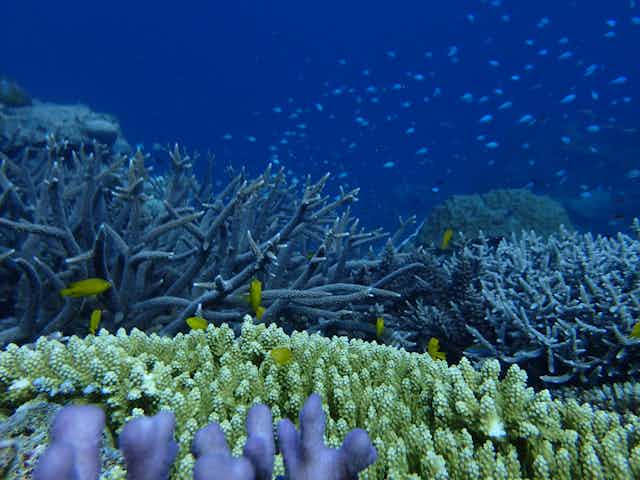Ever had a gut feeling that you have something in common with a coral reef? Well, you do. Both humans and corals rely on microorganisms to function normally.
Across all species, microbiomes – the communities of microorganisms that live with us – support ecosystems by cycling nutrients, fixing nitrogen and breaking down detritus.
In the human gut, our microbiome helps extract nutrients from ingested food, as well as influencing the immune system. We are also beginning to understand how this internal ecosystem can affect our physical and mental health.
Corals are also influenced by their microbiome. Like the human gut, the microbiome is thought to contribute to the success of coral and coral reefs through roles in nutrition, nutrient cycling and protection against diseases.
However, in comparison to the human microbiome, the processes by which coral bacterial populations influence the health and functioning of these important ecosystems are not well known. Some of these bacteria could be the source of new human drugs, or help us understand how bleaching affects corals.
A major challenge is the sheer complexity of coral microbiomes. This makes it difficult to identify the bacteria playing these important roles or to decipher how they interact with the coral.

An unexplored underwater microworld
Corals harbour a microbiome comprising hundreds of thousands of microorganisms (bacteria, viruses, archaea and fungi) organised on a microscale imperceptible to the human eye. A coral colony offers many different spaces for microbes to live in. This array of microhabitats helps make corals one of the most diverse ecosystems in the world.
One coral species can host more than 100,000 different bacteria, and a gram of coral can harbour more than 30,000 bacteria of thousands of different types. The number and types of these bacterial communities can vary across coral colonies, species and reefs.
These communities also change when corals are stressed, such as when they experience changes in environmental conditions, become diseased, or face competition from algae for space. But these relationships are complex, so how can we figure out what’s going on?

Microbes for every purpose
As with a human microbiome, the study of coral bacteria first involves collecting samples (though requiring scuba divers rather than swabs) to collect DNA. The bacterial genomes are then sequenced and the DNA sequences compared against databases of sequences from known bacteria. This comparison has allowed us to classify the microbes.

Through these analyses, it has been possible to identify bacteria present at different stages of corals’ lifespan. These include species involved in cycling nitrogen and sulfur, and rare bacteria that could play a role in transporting nutrients from the photosynthetic algae that live within corals (known as zooxanthellae).
We’ve also identified bacterial species that produce antimicrobial and antibacterial compounds, which help prevent disease and overgrowth of the immobile coral.
However, thousands of the bacterial DNA sequences don’t match anything in current databases. These anonymous bacteria have not been reported in any other ecosystem and are likely to be entirely new bacterial species.
New medicines
The diversity of the coral microbiome is not only fascinating but also offers the tantalising prospect of new medicines and new biologically active compounds.
For example, we urgently need new antibiotics to fight the rapid acceleration of resistance. Almost all of our current antibiotics were first isolated from bacteria. Importantly, no clinically useful antibiotic with a completely new mechanism for fighting infection has been discovered since the 1980s.

New bacterial species offer untapped resources for the discovery of new antibiotics, as well as other bioactive products, if they can be cultured successfully. Cultivating coral bacteria is a huge challenge, but is also an opportunity to understand antimicrobial compounds that exist in nature.
Culturing these bacteria could also enrich resources like the Griffith University Nature Bank, which collects biological samples and shares them with researchers looking for new drugs around the world.
Mine canaries and invisible helpers
It is clear that we have only scratched the surface of the complex ecosystem of coral reefs and their unexplored microbiomes. We are continually learning just how diverse coral systems are, and evaluating how unique and unexplored they remain.
Advances in DNA technologies are enabling us to explore ever more dimensions, but a long and exciting path still lies ahead. Continued analysis of coral reefs and coral microbiomes is important to understand the ecology and biology of corals and coral reefs – and crucially how these are changing, particularly in response to external events such as bleaching and coastal pollution.
Preserving untapped and unexplored resources is also vitally important for the future discovery of new and improved antibacterial compounds.

